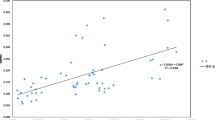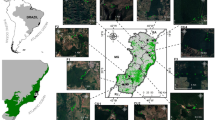Abstract
Euryodendron excelsum is a critically endangered Ternstroemiaceae species endemic to southern China, with only 14 individuals surviving in Ba Jia Zhen of Yangchun, Guangdong Province. Intersimple sequence repeat (ISSR) markers were used to assess genetic variation and relationships among these individuals. Population genetic parameters were estimated by a Bayesian approach as well as conventional methods. Of the 225 loci generated by 21 primers, 147 (65.33%) were polymorphic. Compared with other species of Theaceae and related families, a high level of genetic variation was identified in E. excelsum (Nei’s gene diversity, 0.2458; Shannon’s index, 0.3626). An unweighted pair group method with arithmetic mean (UPGMA) dendrogram showed that the 14 individuals were mainly clustered into three groups, a conclusion further supported by principal coordinate analysis. Based on these results, a management and conservation strategy for E. excelsum was proposed.



Similar content being viewed by others
References
Adams RP, Schwarzbach AE, Pandey RN (2003) The concordance of terpenoid, ISSR and RAPD markers, and ITS sequence data sets among genotypes: an example from Juniperus. Biochem Syst Ecol 31:375–387
Anderberg AA, Rydin C, Källerjö M (2002) Phylogenetic relationships in the order Ericales s.1. analyses of molecular data from five genes from the plastid and mitochondrial genomes. Am J Bot 89:677–687
Barth S, Melchinger AE, Lubberstedt TL (2002) Genetic diversity in Arabidopsis thaliana L. Heynh. investigated by cleaved amplified polymorphic sequence (CAPS) and inter-simple sequence repeat (ISSR) markers. Mol Ecol 11:495–505
Bin XY, Tang SQ, Zhou JY, Song HT, Li ZY (2005) ISSR analysis on genetic diversity of Camellia nitidissima Chi (Theaceae) in China. J Wuhan Bot Res 23:20–26
Camacho FJ, Liston A (2001) Population structure and genetic diversity of Botrychium pumicola (Ophioglossaceae) based on inter-simple sequence repeats (ISSR). Am J Bot 88:1065–1070
Cao PJ, Yao QF, Ding BY, Zeng HY, Zhong YX, Fu CX, Jin XF (2006) Genetic diversity of Sinojackia dolichocarpa (Styracaceae), a species endangered and endemic to China, detected by inter-simple sequence repeat (ISSR). Biochem Syst Ecol 34:231–239
Chang HT (1963) A new genus of Theaceae Euryodendron. Acta Sci Nat Univ Sunyatseni 4:126–130
Chang HT (1981) Systematic studies on the genus of Camellia. Zhongshan (Sun Yat-sen) University Press, Guangzhou
Chang HT (1998) Flora reipublicae popularis sinicae (Tomus 49). Science Press, Beijing
Deshpande AU, Apte GS, Bahulikar RA, Lagu MD, Kulkarni BG, Suresh HS, Singh NP, Rao MKV, Gupta VS, Pant A, Ranjekar PK (2001) Genetic diversity across natural populations of three montane plant species from the Western Ghats, India revealed by intersimple sequence repeats. Mol Ecol 10:2397–2408
Ellstrand NC, Elam DR (1993) Population genetic consequences of small population size: implications for plant conservation. Annu Rev Ecol Syst 24:217–242
Frankham R, Ballou JD, Briscoe DA (2004) A primer of conservation genetics. Cambridge University Press, Cambridge, UK
Fu LG (1989) The rare and endangered plants in China. Shanghai Education Press, Shanghai
Fu LG, Jin JM (1992) Red list of endangered plants in China, vol 1. Science Press, Beijing
Ge XJ, Sun M (1999) Reproductive biology and genetic diversity of a crytoviparous mangrove Aegiceras corniculatum (Myrsinaceae) using allozyme and intersimple sequence repeat (ISSR) analysis. Mol Ecol 8:2061–2069
Hedrick PW (1985) Elephant seals and the estimation of a population bottleneck. J Hered 86:232–235
Holsinger KE, Lewis PO, Dey DK (2002) A Bayesian approach to inferring population structure from dominant markers. Mol Ecol 11:1157–1164
Holsinger KE, Wallace LE (2004) Bayesian approaches for the analysis of population genetic structure: an example from Platanthera leucophaea (Orchidaceae). Mol Ecol 13:887–894
King RA, Gornall RJ, Preston CD, Croft JM (2002) Population differentiation of Potamogeton pectinatus in the Baltic Sea with reference to waterfowl dispersal. Mol Ecol 11:1947–1956
Lai JA, Yang WC, Hsiao JY (2001) An assessment of genetic relationships in cultivated tea clones and native wild tea in Taiwan using RAPD and ISSR maskers. Bot Bull Acad Sinica 42:93–100
Lewontin RC (1973) The apportionment of human diversity. Evol Biol 6:381–398
Luo XY, Tang GD, Xu H, Zhuang XY, Zheng WJ, Zeng M (2005) Genetic diversity of three endemic and endangered species of the family Theaceae in Guangdong. China Biodivers Sci 13:112–121
Marshall DR, Brown ADH (1975) Optimum sampling strategies for gene conservation. In: Frankel OH, Hawkes JG (eds) Crop genetic resources for today and tomorrow. Cambridge University Press, Cambridge
Ming TL, Bartholomew B (2007) Theaceae. In: Wu ZY, Raven PH (eds) Flora of China, vol 12. Science Press: Beijing and Missouri Botanical Garden Press, St. Louis
Nagaoka T, Ogihara Y (1997) Applicability of inter-simple sequence repeat polymorphisms in wheat for use as DNA markers in comparison to RFLP and RAPD markers. Theor Appl Genet 94:597–602
Palacios C, Gonzalez-Candelas F (1997) Lack of genetic variability in the rare and endangered Limonium cavanillesii (Plumbaginaceae) using RAPD markers. Mol Ecol 6:671–675
Pang XF (1993) A brief history of biocoenosis in Nanling mountainous region. Ecol Sci 12:21–33
Prince LM, Parks CR (2001) Phylogenetic relationships of Theaceae inferred from chloroplast DNA sequence data. Am J Bot 88:2309–2320
Rohlf FJ (1993) NTSYS: numerical taxonomy and multivariate analysis system, vol 1.8. Exeter Software, New York
Su YJ, Wang T, Yang WD, Zhu JM (1998) DNA extraction and RAPD analysis of Podocarpus. Acta Sci Nat Univ Sunyatseni 37:13–18
Tsumura Y, Ohba K, Strauss SH (1996) Diversity and inheritance of inter-simple sequence repeat polymorphisms in Douglas-fir (Pseudotsuga menziesii) and sugi (Cryptomeria japonica). Theor Appl Genet 93:40–45
Wang T, Su YJ, Ye H, Ouyang PY, Jiang Y, Sun YF, Chen GP, Deng F, Zhang HT (2005) Genetic differentiation and conservation of 14 surviving individuals of Euryodendron excelsum endemic to China. Acta Sci Nat Univ Sunyatseni 44:68–71
Wang YH, Min TL, Hu XL, Cao LM, He H (2002) The ecological and reproduction characteristics of Euryodendron excelsum, a critically endangered plant from Theaceae. Acta Bot Yunnanica 24:725–732
Wei X, Wei JQ, Cao HL, Li F, Ye WH (2005) Genetic diversity and differentiation of Camellia euphlebia (Theaceae) in Guangxi, China. Ann Bot Fenn 42:365–370
Wolfe AD, Xiang QY, Kephart SR (1998) Assessing hybridization in natural populations of Penstemon (Scrophulariaceae) using hypervariable inter-simple sequence repeat (ISSR) bands. Mol Ecol 7:1107–1126
Wu CC, Hsu ZF, Tsou CH (2007) Phylogeny and taxonomy of Eurya (Ternstroemiaceae) from Taiwan, as inferred from ITS sequence data. Bot Stud 48:97–116
Xue DW, Ge XJ, Hao G, Zhang CQ (2004) High genetic diversity in a rare, narrowly endemic primrose species: Primula interjacens by ISSR analysis. Acta Bot Sin 46:163–1169
Ye HG, Wang FG, Zhou LX, Ye YS, Huang S (2002) Euryodendron excelsum, an endangered plant in Theaceae. Chin J Bot 4:3
Yeh FC, Yang R (1999) PopGene (v. 1.31). Department of Renewable Resources, University of Alberta. http://www.ualberta.ca/_/fyeh
Ying JS, Zhang YL (1994) The endemic genera of seed plants of China. Science Press, Beijing
Zietkiewicz E, Rafalski A, Labuda D (1994) Genomic fingerprinting by simple sequence repeat (SSR) anchored polymerase chain reaction amplification. Genomics 20:176–183
Acknowledgments
The authors thank Dr. Bobby A. Brown of Plant Science Group, Division of Biochemistry and Molecular Biology, Faculty of Biomedical and Life Sciences, University of Glasgow, for advice and revision of English. We also thank Yueshi Ye from South China Botanical Garden, Chinese Academy of Sciences, for assistance with the collection of plant materials. This work was supported by grants from the National Natural Science Foundation of China (grant no. 30271094), the 100 Talent Project of the Chinese Academy of Sciences (grant no. 0729281F02), and the Scientific Research Foundation for the Returned Overseas Chinese Scholars, State Education Ministry of China (grant no. [2003] 406).
Author information
Authors and Affiliations
Corresponding author
Rights and permissions
About this article
Cite this article
Su, Y., Wang, T., Sun, Y. et al. High ISSR Variation in 14 Surviving Individuals of Euryodendron excelsum (Ternstroemiaceae) Endemic to China. Biochem Genet 47, 56–65 (2009). https://doi.org/10.1007/s10528-008-9206-2
Received:
Accepted:
Published:
Issue Date:
DOI: https://doi.org/10.1007/s10528-008-9206-2




